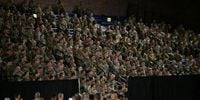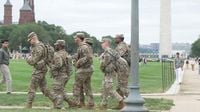On August 11, 2025, President Donald Trump declared a crime emergency in Washington, D.C., setting the stage for one of the most visible—and controversial—federal deployments in the capital’s recent history. Within hours, 800 members of the D.C. National Guard were ordered onto the city’s streets. But what started as a local mobilization quickly ballooned: by August 21, the ranks had swelled to more than 2,000 troops, with National Guard contingents pouring in from West Virginia, South Carolina, Ohio, Louisiana, Mississippi, and Tennessee.
According to reporting by The 51st, West Virginia contributed between 300 and 400 Guard members, South Carolina added 200, Ohio sent 150 military police, Louisiana provided 135, Mississippi sent 200, and Tennessee volunteered 160. This surge, orchestrated by the White House, was justified as a response to what President Trump labeled a dire crime emergency. Yet, official statistics tell a more nuanced story: Washington’s violent crime rate per capita last year was 67% lower than that of Cleveland, according to FBI data cited by Ohio News.
The role of the National Guard in D.C. has been defined as one of support—assisting federal and local law enforcement with community safety patrols, traffic control points, and crowd flow management. However, their law enforcement authority remains limited. Guard members are not generally making arrests, and their visible presence has been noted more in tourist-heavy areas such as Union Station, the Washington Monument, and the Lincoln Memorial, rather than in neighborhoods with the highest crime rates.
“Crime is extremely high right here in Union Station. You have vagrants, you have drug addicts, you have the chronically homeless, you have the mentally ill who harass, who threaten violence, who attack families and they have done it for far too long. This should be a monument to American greatness,” Vice President JD Vance declared during a visit to greet Guard members at Union Station, echoing the administration’s tough-on-crime rhetoric. Yet, for many D.C. residents, the deployment has raised more questions than it has answered.
The cost of this operation is significant. Estimates based on prior figures from 2020 suggest that the current level of activation could cost upwards of $1 million per day for 2,000 troops, with the federal government footing the bill. Dennis Jing, a former logistics officer for the D.C. National Guard, described deployments like these as a “huge lift” that disrupts the lives of hundreds of people called away from their civilian jobs and families.
One of the most frequently asked questions has been whether the National Guard is armed. As of August 21, Guard members on public patrols had not been visibly carrying firearms, though preparations to arm them were underway. A spokesperson explained, “Guard members may be armed consistent with their mission and training.” While the Guard is not authorized to make arrests except in exceptional circumstances, one such incident did occur: a guardsman detained a man allegedly assaulting a U.S. Park Police officer during a traffic stop on the National Mall.
But the deployment has not been without incident. On August 20, a 14-ton mine-resistant military vehicle in a National Guard convoy collided with a civilian car on Capitol Hill, sending the driver to the hospital. The accident was a stark reminder of the practical risks that come with a military presence on city streets.
Supporters of the deployment argue that the National Guard provides a needed visual deterrent to would-be criminals and offers backup for D.C.’s stretched police force. Some local activists and elected officials, including Ward 8 Councilmember Trayon White, have advocated for a National Guard presence for years, hoping it could free up police officers for more direct community engagement.
Still, a recent Washington Post poll revealed that nearly 80% of D.C. residents oppose Trump’s moves in the city, including the National Guard deployment. Critics, both practical and political, abound. On the practical side, many point out that the National Guard is not trained for law enforcement, lacks familiarity with the city’s criminal landscape, and in some cases, diverts resources from local police. Politically, detractors see the deployment as a theatrical show of force.
“The vast majority of them are just going to… stand around. They are not trained [for] law enforcement,” tweeted Daniel Hodges, a D.C. police officer and former National Guard member. “Extremely expensive photo op, and you’re paying for it.”
Ohio’s participation in the deployment is particularly notable given the state’s fraught history with domestic military actions. The memory of the 1970 Kent State shootings, when Ohio National Guard troops killed four unarmed students, still casts a long shadow. Nonetheless, Ohio Governor Mike DeWine defended his decision to send 150 military police to D.C., stating, “This is very similar, frankly, to what we have done in the past. During the Floyd George crisis, we had National Guard that I sent to Cleveland at the request of the mayor of Cleveland. The same way in Columbus. So this is really no different.”
Senator Bernie Moreno, R-Ohio, declined to rule out sending the Guard to high-crime cities like Cleveland, saying, “As of right now, we don’t have plans for that. But I’m never going to say we’re going to take anything off the table.”
Democratic lawmakers, meanwhile, have been unsparing in their criticism. “Trump’s actions are not about addressing crime,” Rep. Joyce Beatty wrote in a statement. “They are about instilling fear in our communities and distracting from the failed tariff policies, unlawful actions and lack of transparency from this administration.”
Local D.C. officials have voiced strong opposition as well. Mayor Muriel Bowser took to social media to declare, “American soldiers and airmen policing American citizens on American soil is #UnAmerican.” She elaborated to reporters, “The question is why the military would be deployed in an American city.” Attorney General Brian Schwalb added, “Let us be clear: armed soldiers should not be policing American citizens on American soil. Instead of making D.C. more secure, it undermines public safety and endangers our democracy. It’s D.C. today, but the same dangerous strategy can be deployed to occupy any American community.”
Underlying the local frustration is the fact that, unlike in any state, the D.C. mayor has no formal control over the city’s National Guard. “This couldn’t be done in neighboring states,” Bowser pointed out. At-Large Councilmember Christina Henderson, after touring the National Mall, questioned the logic of deploying troops to low-crime areas, asking, “What are your troops actually going to be doing here? Because the current ones are not doing a lot.”
As for how long the National Guard will remain, the answer is open-ended. “The activation will remain in place until the president determines that conditions of law and order have been restored in D.C.,” a D.C. National Guard spokesperson explained. With the deployment’s cost mounting daily and no clear end in sight, the city’s residents and leaders alike are left to grapple with the implications of this unprecedented federal intervention—and what it means for the future of policing and democracy in the nation’s capital.



